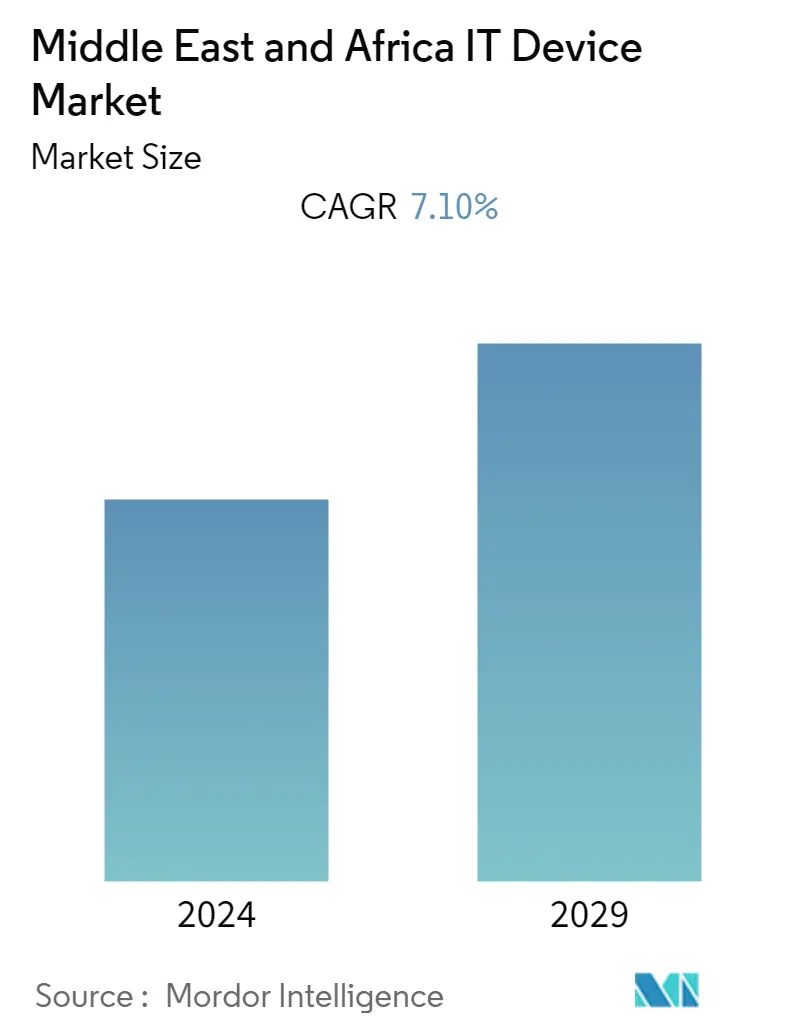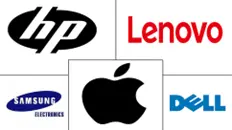Market Size of Middle East and Africa IT Device Industry

| Study Period | 2019 - 2029 |
| Base Year For Estimation | 2023 |
| Forecast Data Period | 2024 - 2029 |
| Historical Data Period | 2019 - 2022 |
| CAGR | 7.10 % |
| Market Concentration | Medium |
Major Players
*Disclaimer: Major Players sorted in no particular order |
MEA IT Device Market Analysis
The Middle East and Africa IT Device market is expected to grow at a CAGR of 7.1% for the next five years. The expanding number of customers is further influencing the market for the product due to the improved quality and features of smartphones, together with their falling prices.
- The Middle East and African PC market is performing stably. Although consumer demand has slightly lessened post-Covid, the PC market is still doing significantly better than before COVID-19. The region's total PC shipments were projected to be more than 14 million units last year. Although the demand for PCs, including laptops, desktops, and tablets, is expected to contract slightly in the coming year, it would again gain back its demand from 2024.
- Gaming laptops with slimline designs and desktop-like performance for gaming and other demanding applications saw an exponential increase in demand last year in the Middle East region. Students and young working professionals now demand gaming laptops because of a thriving gaming environment and the advent of competitive e-sports competitions.
- However, toward the end of the last year, it is not surprising that the demand for the IT device industry in the Middle East and Africa region has begun to decline, given how much of an impact inflation has had on practically every sector of the economy. Rising living expenses have restricted consumer spending on other commodities, especially IT devices.
- Encouragingly, over the period up to 2025, smartphone use is expected to rise substantially in the Middle East and Africa's less developed mobile markets, supported by continuing network investment by operators. Data usage in the region will soar by 430% between the previous year and 2027 because of rising user engagement with bandwidth-hungry apps like video.
- The post-Covid demand for both laptops and smartphones declined in the second quarter of the last year than in the same period during 2020. However, Apple's shipments increased by 2% YoY despite the downturn in the region, mostly due to improved distribution and product accessibility in GCC nations. The pandemic has brought to light the growing significance of digital technologies for crisis response and recovery planning. The crisis has also increased the possibility of accelerating Africa's digital development and created potential demand for mobile phones and PCs, which is expected to have a long-lasting impact.
MEA IT Device Industry Segmentation
As digitalization advances, hardware components are continuously updated to meet the most recent requirements. PCs and phones are the sectors that make up the devices market in the technology market outlook.
The Middle East and Africa IT Device Market is segmented by Type (PCs - Laptops, Desktop PCs and Tablets, and Phones - Land Lines, Smart Phones, and Feature Phones) and by Geography (Saudi Arabia, UAE, Qatar, Kuwait, South Africa, Egypt, Nigeria, and Rest of MEA).
The market sizes and forecasts are provided in terms of value (USD million) for all the above segments.
| By Type | |||||
| |||||
|
| By Geography | |
| Saudi Arabia | |
| United Arab Emirates | |
| Qatar | |
| Kuwait | |
| South Africa | |
| Egypt | |
| Nigeria | |
| Rest of Middle-East and Africa |
Middle East and Africa IT Device Market Size Summary
The Middle East and Africa IT Device market is poised for significant growth, driven by the increasing demand for smartphones and PCs. The region is witnessing a surge in smartphone adoption, fueled by enhanced network coverage and mobile broadband services. This growth is particularly pronounced in the less developed mobile markets, where ongoing investments by operators are expected to substantially boost smartphone usage. The demand for gaming laptops is also on the rise, as a thriving gaming environment and competitive e-sports competitions attract students and young professionals. Despite some decline in demand due to inflation and rising living costs, the market is expected to recover, with smartphones anticipated to dominate the connections landscape by 2025.
The PC market in the Middle East and Africa is experiencing stable performance, with Southern Africa showing robust growth despite global supply chain challenges. The demand for mobile devices like notebooks and tablets is bolstered by corporate backlog orders, work-from-home policies, and the adoption of eLearning technologies. Key players such as Samsung, Dell, Apple, Lenovo, and HP are actively expanding their presence and introducing innovative products to capture market share. The region's IT device market is characterized by a youthful, tech-savvy population and intense competition among manufacturers, driving the introduction of cutting-edge yet affordable technology solutions.
Middle East and Africa IT Device Market Size - Table of Contents
-
1. MARKET INSIGHTS
-
1.1 Market Overview
-
1.2 Industry Attractiveness-Porter's Five Force Analysis
-
1.2.1 Bargaining Power of Suppliers
-
1.2.2 Bargaining Power of Consumers
-
1.2.3 Threat of New Entrants
-
1.2.4 Threat of Substitute Products
-
1.2.5 Intensity of Competitive Rivalry
-
-
1.3 Impact of COVID-19 on the IT Device Industry
-
-
2. MARKET SEGMENTATION
-
2.1 By Type
-
2.1.1 PC's
-
2.1.1.1 Laptops
-
2.1.1.2 Desktop PCs
-
2.1.1.3 Tablets
-
-
2.1.2 Phones
-
2.1.2.1 Landline Phones
-
2.1.2.2 Smartphones
-
2.1.2.3 Feature Phones
-
-
-
2.2 By Geography
-
2.2.1 Saudi Arabia
-
2.2.2 United Arab Emirates
-
2.2.3 Qatar
-
2.2.4 Kuwait
-
2.2.5 South Africa
-
2.2.6 Egypt
-
2.2.7 Nigeria
-
2.2.8 Rest of Middle-East and Africa
-
-
Middle East and Africa IT Device Market Size FAQs
What is the current Middle East and Africa IT Device Market size?
The Middle East and Africa IT Device Market is projected to register a CAGR of 7.10% during the forecast period (2024-2029)
Who are the key players in Middle East and Africa IT Device Market?
HP Inc. , Lenovo Group Limited , Dell Technologies , Samsung Electronics Co., Ltd. and Apple Inc are the major companies operating in the Middle East and Africa IT Device Market.

